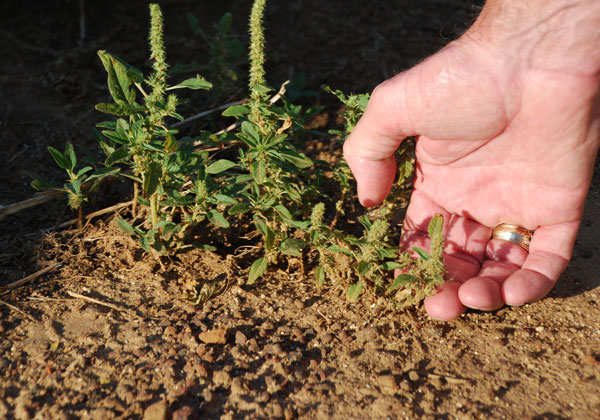November 20, 2013

Palmer pigweed has a big reputation and most of it gained by being a royal pain in the backside for row crop growers from the Florida Panhandle to the Upper Neck of Virginia.
It may have a bigger reputation for problems in the Lower Southeast, but make no mistake, Palmer amaranth is a problem for row crop production anywhere it lives.
As farmers transition from harvesting this year’s crops to planning next year’s, there is time to re-think basic weed control strategies.
A big part of managing a problem is knowing what the problem entails. North Carolina State Weed Scientist Wes Everman says a good first step for farmers in dealing with Palmer pigweed is to be able to accurately identify it at the seedling stage and to differentiate it from smooth and redroot pigweed species.
Once Palmers get mature, few have any problem with identification. However, in the fall and early spring they are easily confused with redroot and smooth pigweed.
How important is knowing the enemy?
In the case of pigweed, more specifically Palmer amaranth, it can be the difference in being in or out of farming.
University of Georgia Weed Scientist Stanley Culpepper has been at the forefront of battling pigweed in general, but glyphosate resistant pigweed in particular for the better part of 10 years now. He has great respect for his foe.
Management systems for Palmer pigweed are effective but costly. Georgia cotton growers spend more than $100 million per year to manage Palmer amaranth, he says.
That’s just one crop and one state. Glyphosate resistant pigweed is now found in multiple states and in multiple crops in the Southeast.
Control not economically sustainable
“One hundred percent of all growers who have had success will tell you the same thing,” Culpepper says,
“I was successful in managing the plant, but I’m not economically sustainable. We’re spending $80, $90, $100 per acre to manage this one plant. We cannot keep doing that.”
Everman says, Palmer pigweed with resistance to glyphosate and active ingredients in other often-used herbicides can be a huge problem throughout most of the calendar year.
Growers unintentionally, but routinely, move Palmer pigweed seed around their farm and to neighboring farms on equipment, even on clothing.
Resistance can move considerable distances on pollen. And, it too can be moved via equipment and other means.
Not only are pigweed seed mobile, plants at all stages of growth are also tremendously resilient, the North Carolina State researcher says.
“It’s very common to see Palmer pigweed get knocked down in the harvesting process with corn or soybeans and the farmer thinks the problem is solved. In many cases, I’ve seen pigweed re-root, take-off quickly and be a big problem,” he adds.
“Even mowing doesn’t always have much effect on pigweed. In some cases, mowing may actually mask a later problem with Palmer amaranth.
“Once mowed, these weeds can become a low growing bush, sit there for a while after grain crops are harvested, then come back out before the first frost and be a major problem the next spring,” Everman says.
Whether Palmer pigweed turn up after summer crops are harvested or during the growing season, the surest way to prevent transfer of seed is to pull the weeds up and destroy them.
Labor aside, another problem with that strategy is being able to identify Palmer pigweed when it’s in the seedling stage.
Everman says there are three good, but not easy ways, to distinguish Palmer amaranth from its less destructive cousins redroot and smooth pigweed.
First, look for tiny hairs along the stem of the weed. These fuzzy little hairs are good indicator that the pigweed you have is NOT Palmer pigweed.
Though the names, especially smooth pigweed indicate differences, these pigweed species do have hairs along the stem of the plant and Palmer amaranth does not.
Second step
Second, pull up a suspect pigweed at ground level. Break the petiole at the stem and fold it back on itself at the base of the leaf. If it’s Palmer amaranth, the petiole will be the length of the leaf or longer. Petiole length of Palmer pigweed is significantly longer than other pigweed species.
Finally, on suspect pigweed look carefully at the top of the leaf for a notch. Then, look even closer at the notch to determine whether there is a hair in the notch. Redroot and smooth pigweed will not have the hair in the notch on top of the leaf.
Once it is determined the weeds are Palmer amaranth, then the fun begins — how to get rid of it. Pulling Palmer pigweed isn’t easy. “I’ve seen the root system of a mature Palmer pigweed run across three or four rows of cotton or soybeans,” he says.
It’s real easy to pull up a Palmer pigweed plant and snap the plant off at root level and think you have solved the problem — at least for that weed. However, many times the weed just sprouts new branches and keeps on growing.
Palmer pigweed puts on seed until first frost and can be a problem most of the year in the Southeast.
Everman says growers should be diligent all the time in looking for pigweed, especially those that may have developed resistance to glyphosate or any number of ALS-based herbicides used to control them.
If a grower is using any of the PPO herbicides for postemergence control, they must be very timely in application. Otherwise, when Palmer pigweed gets more than four inches or so tall, control becomes ‘iffy’ at best and can be significantly influenced — in a bad way — by weather.
Most growers know how to control weeds and once pigweed, or most weed species get to a mature size, growers can easily recognize them and manage them.
Pigweed are a little different because of this blend of resilience and their prolific reproductive capabilities.
“I’ve sprayed plots with a backpack sprayer and with the spray going out in front of me, I’ve left a footprint in the soil. I can come back some time later and see where pigweed have germinated around the edge of footprint,” the North Carolina State researcher says.
“As growers head into some down time after harvesting their summer crops, it is an easy time to get complacent on weed control, but that can be a big mistake with Palmer pigweed,” Everman says.
About the Author(s)
You May Also Like






